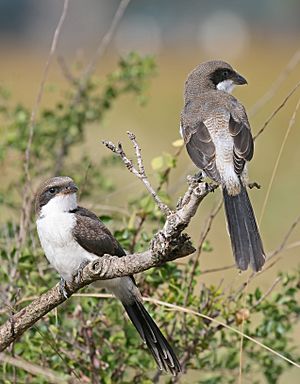Long-tailed fiscal facts for kids
Quick facts for kids Long-tailed fiscal |
|
|---|---|
 |
|
| Young Long-tailed fiscals | |
 |
|
| Adult Long-tailed fiscal | |
| Conservation status | |
| Scientific classification | |
| Genus: |
Lanius
|
| Species: |
cabanisi
|
The Long-tailed fiscal (Lanius cabanisi) is a type of bird that belongs to the shrike family. Shrikes are known for their strong, hooked beaks. This bird is a close relative of the grey-backed fiscal. Sometimes, scientists place it in a special group called Neolanius along with its relative.
You can find the Long-tailed fiscal in parts of southern Somalia, southern and southeastern Kenya, and northern and eastern Tanzania. It lives in dry, open areas like savannas (grasslands with scattered trees), open woodlands, and even farmlands.
These birds are easy to spot! They often sit out in the open, especially on telegraph poles or wires. You might see them wagging their long tails from side to side when they get excited. You can tell them apart from the common fiscal because the Long-tailed fiscal has a gray back and a stronger, more solid body shape.
What Does the Long-tailed Fiscal Look Like?
Like many shrikes, adult male and female Long-tailed fiscals look quite similar. However, young birds look very different from their parents. Adult birds are about 26 and 30 cm (10–12 in) long, which is roughly the length of a school ruler. They weigh between 69 and 80 g (2.4–2.8 oz), which is about the weight of a small apple.
These birds are large and have a strong build. As their name suggests, they have very long tails that get shorter towards the end (called "graduated tails"). They also have the typical strong, heavy beaks that shrikes use for hunting. The Long-tailed fiscal has a more compact body and less slender feet compared to the common fiscal.
How Does the Long-tailed Fiscal Behave?
The Long-tailed fiscal mainly eats insects, especially beetles and grasshoppers. But it also hunts small animals like lizards, snakes, and even baby birds. These birds can be seen alone or in small groups.
They hunt in a typical shrike way: they perch (sit) about two meters (about 6.5 feet) off the ground. From there, they watch carefully for prey. Once they spot something, they dive down to catch it. They usually grab their food from the ground or from plants, but they rarely catch things in the air.
Scientists have noticed something interesting about Long-tailed fiscals and red-billed buffalo weavers in Tsavo, Kenya. They seem to help each other! The fiscals benefit by catching grasshoppers and other insects that the weavers scare up while they are looking for food. In return, the weavers benefit from the alarm calls made by the fiscals, who are very watchful and warn them of danger.
Images for kids




